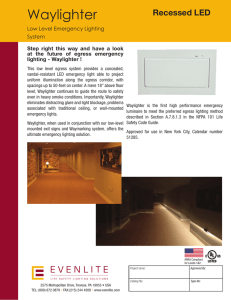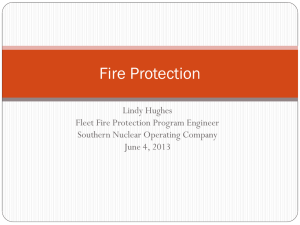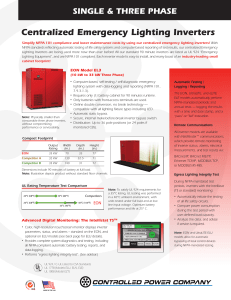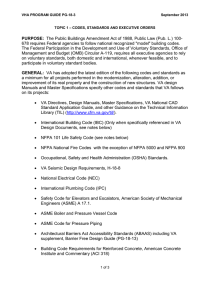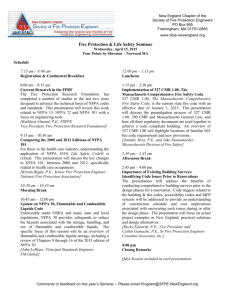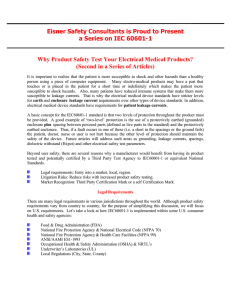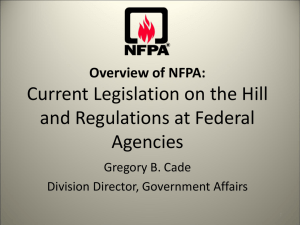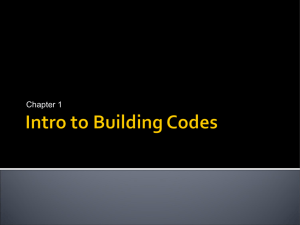Iota EM Lighting code presentation
advertisement
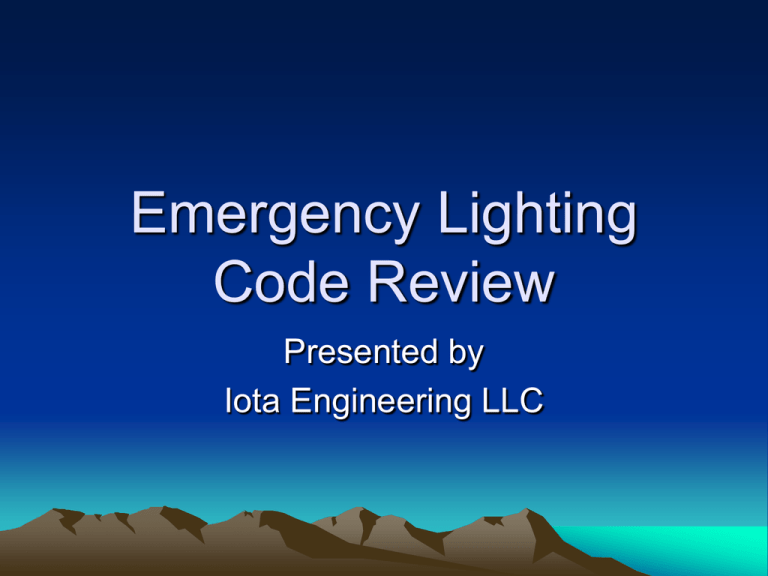
Emergency Lighting Code Review Presented by Iota Engineering LLC Codes • (IBC) International Building Code • NFPA 101 (Life Safety Code) • (NEC) National Electric Code Codes • • • • • Know which code/ revision applies Know the Authority Having Jurisdiction (AHJ) interprets and enforces codes There may be more than one Building inspector, Fire Marshall, Electrical Inspector, Liquor Authority • IBC, NEC and NFPA develop codes, municipalities adopt Performance • Code requires at least 90 minutes of continuous operation • Local or state codes may require longer run time/ higher light levels in certain applications • NFPA 101 Chapter 5 & 6 Classification of Occupancy • Must be operational within 10 seconds of loss of normal power • Sources must be positioned to mark changes in the path of egress NFPA 101 Chapter 6 • • • • • • • • • Assembly Educational Day Care Health Care Detention Business Industrial Storage Hotels & Motels Performance • Exit access and exit discharge • Must provide illumination out of the building to the “public way” • Public Way = “ a street or alley or other parcel of land open to the outside air dedicated for public use” • Or at least 50’ from the building • The height and width must be at least 10’x 10’ NFPA 101 4.5.3.3 • “Every exit shall be clearly visible, or the route to reach every exit shall be conspicuously indicated. Each means of egress, in its entirety shall be arranged or marked so that a way to a place of safety is indicated in a clear manner.” • Some AHJs require exits to be mounted at no more than 10’ AFG Performance • Must be arranged to provide an initial average of one foot-candle through the path of egress • Minimum of .1 foot-candle • 40:1 max to min • Must have at least 60% of initial emergency illumination at the end of 90 minute run time Testing • • • • 30 second test every 30 days Full 90 minute test once a year Written testing records must be kept Written records need not be kept if a computer based testing system is used and is capable of providing a history of code required tests. Must keep written records of failure/ faults and repairs • Self testing units only require a visual inspection monthly Dimmer Systems • (NEC) 700.23 • Added to 2008 code • Dimmer systems can be used as control device for energizing emergency lighting circuits • Panel must be labeled that it is listed for emergency circuits Methods • • • • Generator Inverter Bug eyes Battery packs Methods • Special attention should be given to the type of occupancy before choosing a method • Refer to NFPA 101 Chapter 6 Generators • Full light output to a dedicated EM fixtures • Extended run time • Must be maintained and tested according to code requirements • Needs to be located to minimize hazards that could cause a failure of the system • Start up time • NFPA110 standard for generators Generators • • • • • On site fuel storage Must have fuel containment facility Noise and air pollution Requires factory start up Maintenance Inverters • Self contained • Maintenance free batteries minimal environmental impact • Some are fast transfer • Operates all lamp types if fast transfer • Operates multiple fixtures • UPS does not meet the requirements for emergency lighting unless it is tested to and is listed for UL924 Inverters • • • • Larger units require factory start up Large inverters require large foot print Some battery types must be exercised Maintenance Battery Packs • Self contained • Maintenance free • Use same fixture for EM, “aesthetically pleasing” • Must be on same branch circuit as AC ballast • Instant on • Vandal resistant Battery Packs • Single fixture application • Fluorescent lamps only • 7-10 year life Bug Eyes • Self contained • Maintenance free batteries • Must be connected to branch circuit supplying normal lights • Available in different NEMA ratings • Instant on • Cheap Bug Eyes • Uneven light distribution • Not aesthetically pleasing Article 708 • Critical Operations Power Systems (COPS) • Added to NEC for 2008 Article 708 • FPN No.1:Critical Operations Power Systems are installed in vital infrastructure facilities that if incapacitated would disrupt national security, the economy, public health or safety Article 708 • Provides the requirements for the installation, operation, control and maintenance of electrical systems with a high degree of reliability and resiliency to natural disaster and other threats Article 708 • Addresses homeland security issues for facilities that are “mission critical” • These systems must continue to operate during the full duration of an emergency Article 708 • Police stations • Fire stations • Hospitals Article 708 • Many of the same rules that govern the installation, wiring and testing of emergency lighting power systems govern this article Trends • Some municipalities requiring higher light output for unit equipment • Higher mounting heights • Self Diagnostics • Lamp/ ballast compatibility • LED Lighting

